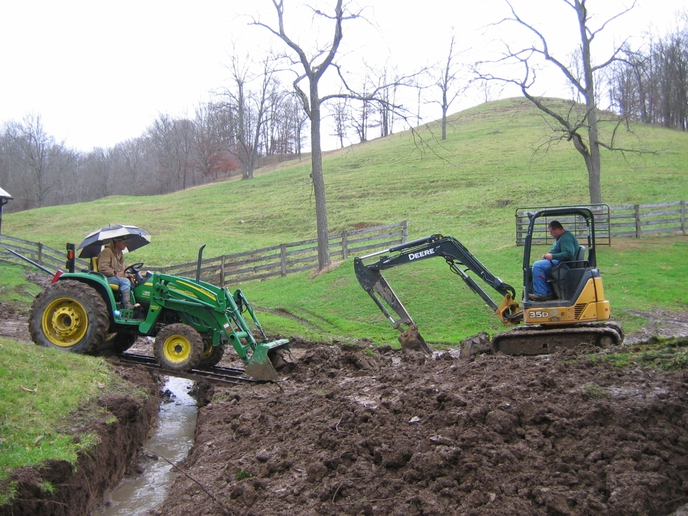Culvert Installation Made Easy: Step-by-Step Guide for Success
Setting up culverts may appear like a simple task, yet ensuring a successful end result calls for cautious planning and execution. From choosing the suitable culvert dimension to incorporating appropriate water drainage steps, each action in the installment process plays an essential role in the functionality and longevity of the culvert system. By adhering to a systematic approach and paying attention to crucial information, the installment can continue efficiently, decreasing possible concerns down the line. Keep tuned to uncover the important steps and considerations that can make culvert setup a smooth and successful endeavor.
Selecting the Right Culvert Size
Picking the proper culvert dimension is essential for ensuring efficient water flow and architectural integrity in culvert setup projects - Pad Construction. The size of the culvert directly influences the circulation capacity of water with the structure. A culvert that is also small can result in flooding and overflow, while one that is too huge might result in reduced water speed, possibly triggering sediment accumulation and blockages
To identify the right culvert dimension, variables such as the watershed area, peak flow prices, and hydraulic efficiency demand to be carefully thought about. Computations based upon these criteria aid in picking a dimension that can effectively manage the expected water quantity while decreasing the risk of blockages and architectural failure.
It is vital to consult design standards and requirements to ensure that the chosen culvert size meets the task requirements and regional laws (Pad Construction). By choosing the ideal culvert size, job managers can maximize water flow, avoid prospective concerns, and improve the overall effectiveness and long life of the culvert setup
Preparing the Installment Site
Reliable culvert installment necessitates precise prep work of the installment website to ensure optimal architectural support and capability. Before commencing the installation process, it is crucial to clear the website of any debris, vegetation, or blockages that can impede the culvert's positioning.
Additionally, it is very important to think about factors such as dirt composition, groundwater degrees, and environmental impacts when preparing the installation website. Carrying out a thorough site evaluation can help identify any potential difficulties or dangers that may influence the culvert's efficiency. By taking the time to prepare the installment website appropriately, you can aid guarantee a successful culvert installation that satisfies architectural demands and makes certain long-lasting capability.
Putting the Culvert Correctly

The quality at which the culvert is placed is essential for keeping a proper incline for water circulation. A gradual incline assists protect against pooling and advertises effective drainage. Furthermore, the culvert should be oriented correctly to guarantee that the inlet and outlet remain in the correct locations. This positioning is essential for the culvert to work successfully in managing water circulation.
Backfilling and Compacting the Dirt
Appropriate backfilling and compaction of the dirt around the culvert is vital to guarantee security and avoid possible concerns in the future. Once the culvert is properly placed, the following vital action is to backfill the location around it with suitable product. The backfill product should be without rocks, debris, and raw material to prevent damage to the culvert. It is advised to make use of granular product such as sand or crushed rock for backfilling, as it offers excellent drainage and compaction residential properties.
After placing the backfill material, it is very important to small it in layers of consistent density. Utilizing a compactor or a mechanical meddle, portable the dirt delicately to avoid damaging the culvert. Compaction aids in minimizing the chances of look at this now negotiation and ensures consistent assistance around the culvert. It is important to compact the soil equally on all sides of the culvert to maintain its structural honesty.
Correct backfilling and compaction why not try these out not just provide stability to the culvert yet also aid in stopping soil disintegration and keeping the longevity of the culvert system.
Making Sure Proper Water Drainage Integration
Integrating effective drainage services plays a critical function in the general functionality and long life of culvert setups. Proper water drainage assimilation is vital for handling water flow, avoiding disintegration, and making certain the structural honesty of the culvert system. To accomplish this, it is vital to develop an extensive drain strategy that thinks about variables such as the volume of water anticipated, the topography of the area, and the kind of dirt existing.

In addition, including functions like disintegration control actions, such as riprap or greenery, can even more boost the performance of the drain system. By very carefully planning and applying these water drainage solutions, culvert setups can operate successfully and hold up great site against the examination of time.
Final Thought
To conclude, proper culvert installment is crucial for preserving reliable water drainage systems. By picking the best culvert dimension, preparing the installation website, putting the culvert appropriately, backfilling and condensing the dirt, and ensuring appropriate drain assimilation, success can be accomplished. Following these steps will assist make sure the longevity and effectiveness of the culvert, inevitably adding to the total success of the drain system.